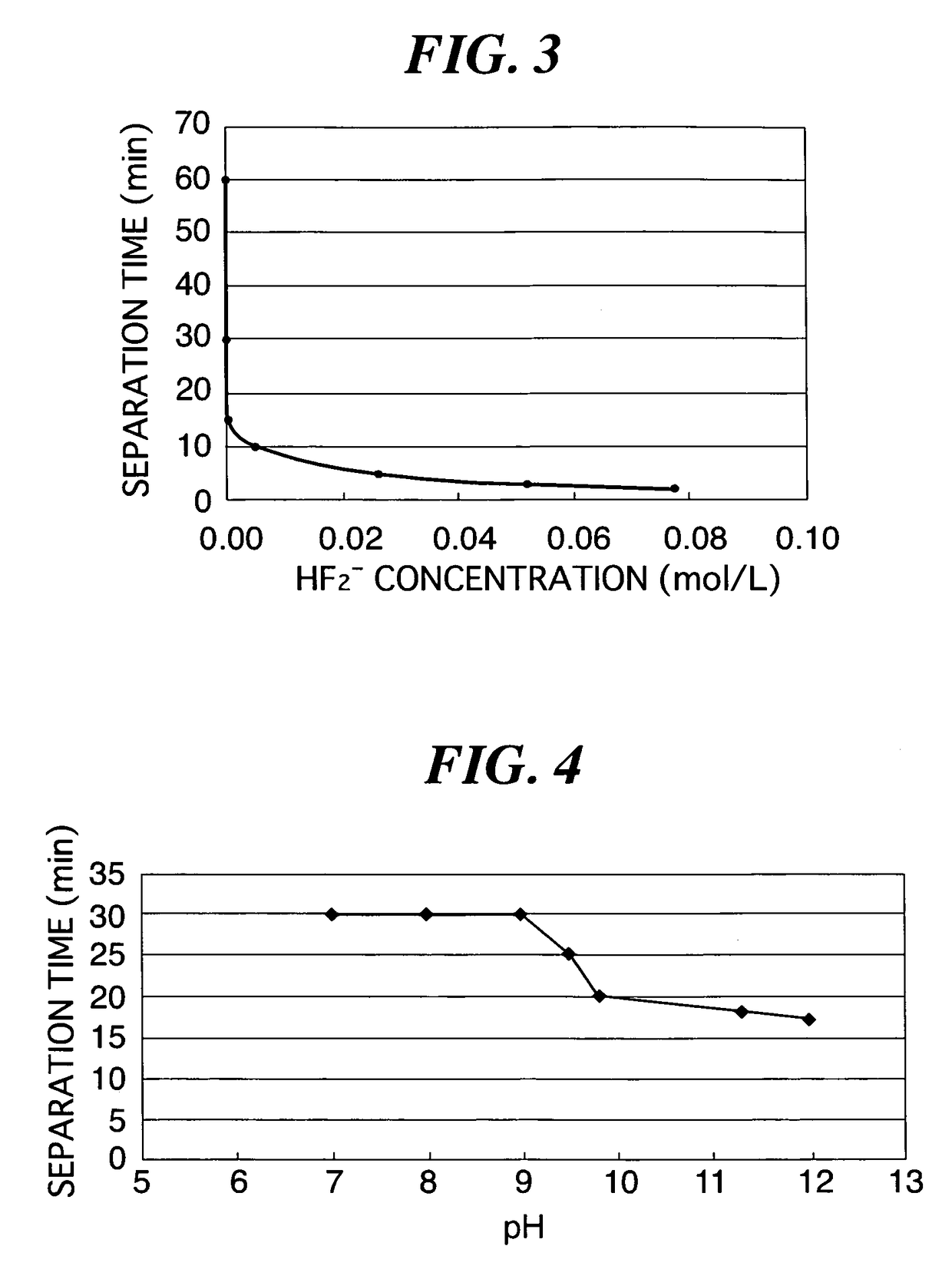Interlayer film separation method
a technology of interlayer film and separation method, which is applied in the field of interlayer film separation method, can solve the problems of not being economically preferable and not being recyclable, and the interlayer film cannot be collected in a recyclable condition
- Summary
- Abstract
- Description
- Claims
- Application Information
AI Technical Summary
Benefits of technology
Problems solved by technology
Method used
Image
Examples
example 1
[0057]In Example 1, the interlayer film separation solution 21 was introduced into the container 22, and the introduced interlayer film separation solution 21 was controlled to a temperature of 40° C., and the laminated glass 10 with cracks reaching interfaces 14, 15 in the glass plates 11, 12, respectively, was introduced into the barrel 23 with the metal pieces 25 and immersed in the interlayer film separation solution 21. In this case, six types of treatment liquids (samples 1 to 6) were prepared so that the HF2− concentration were 0 to 0.08 mol / L as the interlayer film separation solution 21. Each of these treatment liquids was obtained by diluting an aqueous solution of about 23 mol / L (46 wt %) hydrofluoric acid with water.
[0058]Concentrations of hydrofluoric acid aqueous solutions, HF2− concentrations, etching rates, and time (separation time) until glass is completely separated from the laminated glass 10 (a weight ratio of a total weight of the glass plates 11, 12 to a total...
example 2
[0063]In Example 2, an interlayer film separation solution 21 was introduced into a container 22, and the introduced interlayer film separation solution 21 was controlled to a temperature of 40° C., and laminated glass 10 with cracks reaching interfaces 14, 15 in glass plates 11, 12, respectively, was introduced into a barrel 23 with metal pieces 25 and immersed in the interlayer film separation solution 21. In this case, 7 types of potassium hydroxide aqueous solutions were prepared as the interlayer film separation solution 21 so that the hydrogen ion concentration (pH) were 7 to 12. Each of these potassium hydroxide aqueous solutions was obtained by dissolving potassium hydroxide in water and adjusting the resulting solution to have a concentration of 0 to 0.1 wt %. FIG. 4 is a graph showing the relationship between a hydrogen ion concentration (pH) and time until a residual rate of glass becomes 0% in an interlayer film separation solution (40° C.) according to the present embod...
example 3
[0065]In Example 3, an interlayer film separation solution 21 was introduced into a container 22, and the introduced interlayer film separation solution 21 was controlled to a temperature of 40° C., and laminated glass 10 with cracks reaching interfaces 14, 15 in glass plates 11, 12, respectively, was introduced into a barrel 23 with metal pieces 25 and immersed in the interlayer film separation solution 21. In this case, an acidic aqueous solution containing hydrofluoric acid (HF2− concentration: 0.005 mol / L) and a surfactant (0.5 wt %), and having a hydrogen ion concentration (pH) of 1.9 was used as the interlayer film separation solution 21. An etching rate and a surface tension of this acidic aqueous solution were 30 nm / min and 35 N / m, respectively. In addition, time until a residual rate of glass becomes 0% was 9 minutes. It was found from the comparison with the time until a residual rate of glass becomes 0% (10 minutes) when the laminated glass 10 was immersed in Sample 3 in ...
PUM
| Property | Measurement | Unit |
|---|---|---|
| temperature | aaaaa | aaaaa |
| size | aaaaa | aaaaa |
| surface tension | aaaaa | aaaaa |
Abstract
Description
Claims
Application Information
 Login to View More
Login to View More - R&D
- Intellectual Property
- Life Sciences
- Materials
- Tech Scout
- Unparalleled Data Quality
- Higher Quality Content
- 60% Fewer Hallucinations
Browse by: Latest US Patents, China's latest patents, Technical Efficacy Thesaurus, Application Domain, Technology Topic, Popular Technical Reports.
© 2025 PatSnap. All rights reserved.Legal|Privacy policy|Modern Slavery Act Transparency Statement|Sitemap|About US| Contact US: help@patsnap.com


